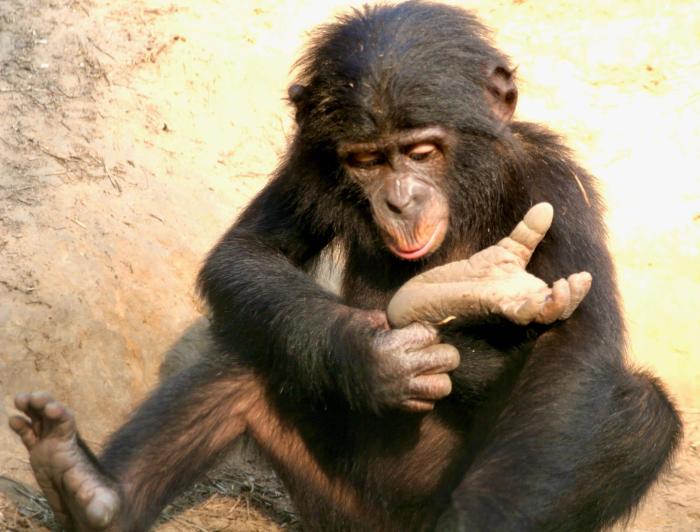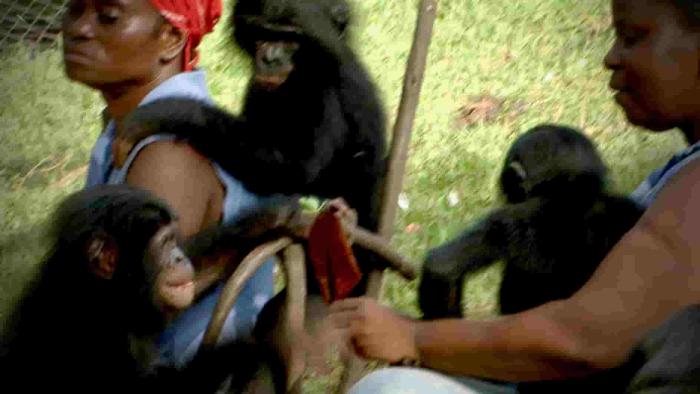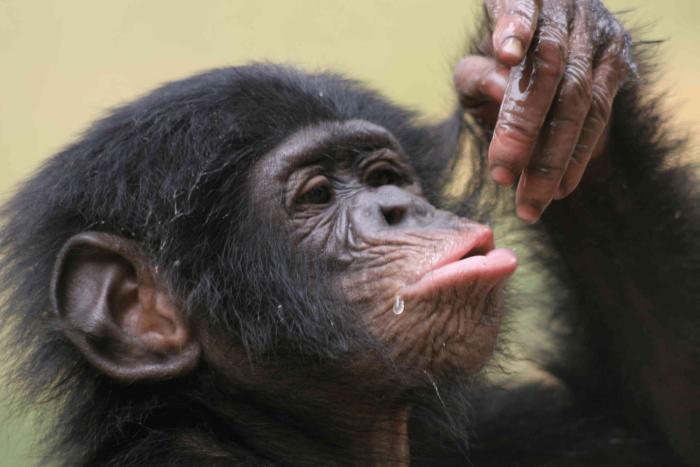
Our closest living relatives are the great apes, which include gorillas, orangutans, chimpanzees, and bonobos. Living in the forests south of the Congo River in the Democratic Republic of the Congo (DRC), bonobos are perhaps the most intelligent ape, since they are the only great ape with no lethal aggression. Led by females, they enjoy strong social bonds and do not kill each other (unlike chimpanzees and humans). Studying bonobo society and social behavior offers us the opportunity to learn more about human evolution.
Sake peers at a green mantis, her eyes level with its alien-shaped face. Its abdomen is shaped like a giant green leaf — when she touches it, the mantis leaps away. Sake smiles.
Sake is a bonobo, one of our closest living relatives. She lives at Lola ya Bonobo in Democratic Republic of the Congo, the largest bonobo conservation initiative and sanctuary in the world. Orphaned by the bushmeat trade, Sake found a new home in the hundred-acre forest outside the capital, Kinshasa, where she lives with other orphans, many of whom will be released back into the wild.

Sake peers at a mantis
At seven years old, Sake loves playing with animals: frogs, crickets, and anything else she can catch. She follows the mantis with some of her friends, playfully swiping at it to see it jump until her friends nudge her into playing a game of chase.
Watch biophilic bonobos interact with a mantis and with water
The late ecologist and author E.O. Wilson would have been delighted with Sake, especially because she is a bonobo (Pan paniscus). Sake’s attraction to living creatures is evidence for his biophilia hypothesis, where he defined biophilia as “an innate tendency to focus on life and life-like processes” and later, in relation to humans, as “the innately emotional affiliation of human beings to other living organisms.” Wilson argued that biophilia is part of our evolutionary heritage, which means it should be present in our closest living relatives. Bonobos, who share 98.7% of our DNA, certainly fit that criterion.
Wilson would have found Sake’s behavior even more inspiring because bonobos are an endangered species. They live only in the Congo Basin, one of the most biodiverse habitats in the world. Wilson intended that biophilia could be used as a conservation ethic — an impetus to conserve biodiversity beyond economic or utilitarian justification.

Sake the brave and biophilic bonobo examining her foot
Since 2008, our research group at the Cognitive Behavioral Lab in Horticultural Sciences at North Carolina State University has worked for the conservation of bonobos through education. We study how they think and solve problems and use what we find to introduce them to more people — how they can cooperate under stressful circumstances, how they see every stranger as a friend, and importantly, what they can teach us about ourselves. As conservationists, we depend on education to be the key to changing people’s behavior.
This philosophy is the driving force behind all conservation education. As the Senegalese Forestry engineer Baba Dioum said to the International Union for the Conservation of Nature (IUCN) in 1968, “In the end, we will conserve only what we love, we will love only what we understand, and we will understand only what we are taught.”
However, the awareness of the biodiversity crisis has not stopped or even slowed biodiversity loss in the last decade, which is estimated to be 1,000 times higher than the background extinction rate. Despite an abundance of national and international treaties, too many countries have failed to take action. Even though the World Economic Forum named biodiversity loss the third most critical cause for global concern — ahead of terrorist threats and cyberattacks — a third of Americans report having little or no concern about the quality of the environment, and biodiversity loss is not even a factor in their top concerns.
If biophilia is a universal human trait, then the lack of impetus and concern doesn’t make sense.
Kata is another female bonobo who lives at Lola Ya Bonobo. Unlike Sake, Kata doesn’t like bugs. In fact, she finds most living creatures terrifying. Upon encountering the same Congo green mantis as Sake, she grimaces in fear, screams, and runs away. It’s not that Kata is scared of everything new and surprising. She loves new toys. She likes to explore and make new friends — but only with species she is familiar with. Also, she is terrified of snakes. Whenever the bonobos find a snake in the forest, most band together and alarmingly warn everyone away. Sake is right at the front, staring in fascination. Kata is nowhere to be seen — she runs as fast and as far as possible, sometimes right back to her bed.

Kata fear grimacing at the mantis
In so much of the research into biophilia, nature seems to benefit everyone. Is this true? Could biophilia vary among people, just as it seems to vary in bonobos? And could this variation explain the disconnect between what everyone says should happen in regards to biodiversity conservation and what is actually happening?
Conservationist Aldo Leopold wrote, “There are some who can live without wild things, and some who cannot.” With this in mind, our research group came up with the concept of a Biophilia Quotient (BQ), similar to IQ, but instead of measuring intelligence, BQ measures your individual attraction to biodiversity. According to our early results, biophilia does seem to vary in people.
Someone with high BQ feels drawn to wild, biodiverse spaces, like coral reefs and tropical forests — even though there might be some discomfort, like hot weather and bugs. People with a high BQ welcome and embrace wildlife in and around their homes, are conscious of herbicide and pesticide use, and, like Sake, are curious and fascinated with all living things.
You probably know someone with a high BQ. They can live in a tent for months, and if they spend too long indoors or cooped up in a city, they begin to feel restless and suffer in some way. Someone with a low BQ prefers beautiful indoor spaces and more curated nature, such as neat landscaping or a vast, smooth lawn. They are not necessarily fearful but are jittery around insects, lizards, and mice, and they never want to meet a snake outside of a zoo. They would much rather visit every museum and gallery in Paris than hike the Grand Canyon. And between these two extremes are the rest of us.

Kata playing with water
Measuring our Biophilia Quotient is important because as we humans hurtle toward complete urbanization, there are going to be some who adapt quickly, those who, like astronauts, thrive in a controlled environment where technology makes so many extraordinary things possible. Then there will be those who will truly suffer. They will mourn the loss of animals they have never seen and struggle, day after day, for reasons they don’t truly understand. They will, as E.O. Wilson wrote,
… grow up with the outward appearance of normality in an environment largely stripped of plants and animals… Asked if they were happy, these people would probably say yes. Yet something vitally important would be missing…
We expect that this will be especially true for children. A phenomenon that journalist Richard Louv refers to as “nature deficit disorder” has been increasing since the free-range childhoods of the 1970s and 80s turned into something else. Frightened by possible kidnappings, parents began to supervise their children more closely. Technology has disrupted childhood even more, so most of their waking hours are spent indoors and on devices.
Again, we expect variation in how this affects children. For some, we expect it will be detrimental, not just to their mental health, but to their ability to flourish. Accurate measurement of BQ, a process our team continues to develop, will allow us to identify who these children are, where they are, and how to help them.
For example, we have found that people with the lowest income have the highest average BQ. People in households that earn less than $25,000 a year have a greater attraction to biodiversity in and around the home — what we call Backyard Biophilia — than those that make $150,000 or more a year.
“Urban distress areas” are characterized by high poverty, a lack of infrastructure, and the absence of the high-quality green spaces that characterize more affluent neighborhoods. It seems that those who live in these areas are more likely to yearn for a wild, messy garden that attracts all sorts of wildlife rather than a neatly manicured lawn. Perhaps biodiversity, in ways we do not understand, alleviates feelings of deprivation.
As we fight to slow climate change and ecosystem collapse, protection of the tropical forest homes of Sake and Kata is critical, but protecting our own homes is also important. Urban and suburban environments are not lost causes. There are ways to increase biodiversity where we live, such as providing corridors for wildlife and highways for butterflies. While it’s true that there are some who can live without wild things, for those who can’t, a biodiverse environment they can see, hear, and touch is necessary, not just for the absence of suffering, but to truly flourish.

Lola ya Bonobo is the world’s largest bonobo sanctuary